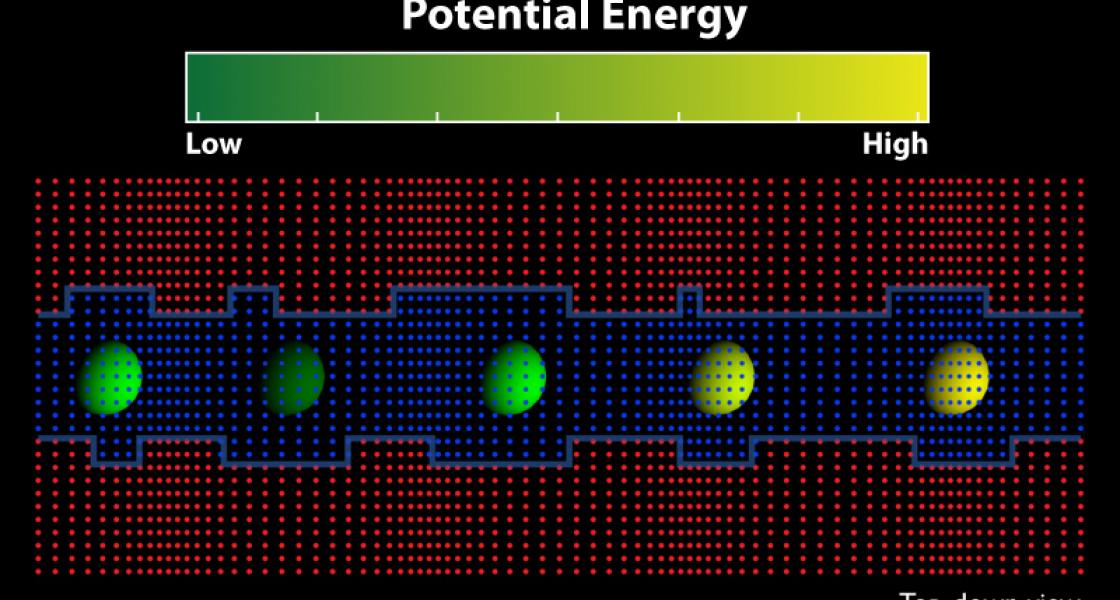In Fellow Steve Cundiff’s lab, echoes of light are illuminating the quantum world. Former Graduate Student Gina Lorenz used a technique known as echo peak shift spectroscopy to probe the interactions of potassium atoms in a dense vapor. Research Associate Sam Carter then used the same method to investigate the interactions of excitons confined in two-dimensional semiconductor quantum wells.
In semiconductors, an exciton forms when light promotes an electron from the valence band to the conduction band, leaving behind a positively charged hole in the valence band. The electron and the hole it leaves behind bind together to form an exciton, which is similar to a hydrogen (H) atom. However, it is much larger than an H atom, extending over many lattice sites in the semiconductor crystal. For this reason, excitons are a good model for long-range atomic interactions that take place in a dense vapor. There atoms are close enough together that excitation from an ultrafast laser can travel from one atom to another. The wave functions of excited atoms spread out in a dense vapor like exciton wave functions stretch across multiple lattice sites in semiconductors.
Both dense atomic vapors and semiconductor excitons can be probed with echo peak shift spectroscopy. In this technique, three laser pulses (incident from three different directions) are sent sequentially into a sample. The first pulse excites the atoms (or excitons), causing oscillations at the resonance frequency. The second pulse interacts with this excitation to form a transient grating (a periodic spatial variation in the level of excitation). The third pulse is diffracted by the grating and measured. Interactions with other atoms (excitons) or with the environment cause the oscillations to rapidly get out of phase. However, if the pulses are ordered correctly, the oscillating atoms (excitons) can come back into phase after the third pulse, forming an echo in the diffracted beam. However, if oscillation frequencies change because of atomic (excitonic) interactions or variations in the local environment, the echo signal is lost.
By varying the time delay between the first two pulses, the researchers can precisely determine the degree to which the original frequencies are retained. This measurement gives the maximum echo signal (the echo peak shift). When measured as a function of the time delay between the 2nd and 3rd pulses, the delay of the echo signal decays to zero as the frequencies of the oscillating atoms (excitons) are randomized. Using this measurement, the researchers were able to understand the interactions that lead to loss of coherence in the two systems. They were also able to estimate the duration of specific kinds of interactions.
With dense atomic vapors, for example, Lorenz was able to identify two types of interactions, close-range hard-core interactions and long-range resonant interactions. Her experiment and theoretical calculations showed that the resonant interactions lasted much longer than the close-range ones. This finding could assist in using atomic vapors to store and transmit quantum information.
The preservation of quantum information is also a motivation for the echo peak shift spectroscopy studies of excitons in quantum wells. However, unlike atoms in a dense vapor, excitons in quantum wells experience varying local environments due to sample imperfections and lattice vibrations. This variation leads to a variety of responses in the semiconductor echo peak shift spectroscopy studies. For instance, Carter found a fast decrease in the echo delays in the first picosecond and an increase over the next few picoseconds, followed by decay to a small offset over tens of picoseconds.
Carter was able to use these responses to analyze how microscopic fluctuations in the quantum well width affect excitons. For instance, he found that many excitons prefer to stay mostly in one place. However, some excitons move from one position to another because of lattice vibrations. The spectrum of lattice vibrations that interact with excitons provides information on how far excitons spread out in imperfect quantum wells. - Julie Phillips



 The Physics Frontiers Centers (PFC) program supports university-based centers and institutes where the collective efforts of a larger group of individuals can enable transformational advances in the most promising research areas. The program is designed to foster major breakthroughs at the intellectual frontiers of physics by providing needed resources such as combinations of talents, skills, disciplines, and/or specialized infrastructure, not usually available to individual investigators or small groups, in an environment in which the collective efforts of the larger group can be shown to be seminal to promoting significant progress in the science and the education of students. PFCs also include creative, substantive activities aimed at enhancing education, broadening participation of traditionally underrepresented groups, and outreach to the scientific community and general public.
The Physics Frontiers Centers (PFC) program supports university-based centers and institutes where the collective efforts of a larger group of individuals can enable transformational advances in the most promising research areas. The program is designed to foster major breakthroughs at the intellectual frontiers of physics by providing needed resources such as combinations of talents, skills, disciplines, and/or specialized infrastructure, not usually available to individual investigators or small groups, in an environment in which the collective efforts of the larger group can be shown to be seminal to promoting significant progress in the science and the education of students. PFCs also include creative, substantive activities aimed at enhancing education, broadening participation of traditionally underrepresented groups, and outreach to the scientific community and general public.